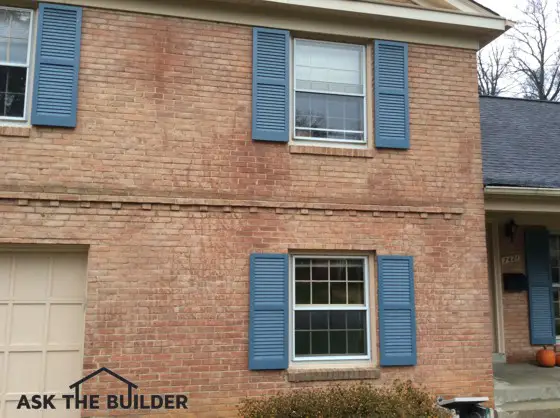Clean Brick Wall Exterior
DEAR TIM: I’ve got a real mess on my hands. I removed ivy from my brick home and the brick is now splotchy. The brick had a slight sanded texture that was lighter in color than where the the ivy was growing. When I removed the ivy, the sand came off and exposed a darker red color of the brick. It’s a very light coating of sand. Is there a way to add the sand back to make the brick appear uniform in color once again? What are the challenges? What are my options? What would you do? Jim H., Falls Church, VA
DEAR JIM: The photograph you sent sure tells the tale. The brick does look like it’s seen better days, that’s for sure. Some find ivy growing on brick to be attractive. From a builder’s standpoint, it’s a huge mistake. You’re very lucky because the damage from the ivy’s tenacious roots can be significant once it starts to find it’s way into hairline cracks of the mortar. It also traps moisture against the brick and that’s never a good thing.

The splotchy appearance of this brick home can be transformed so it looks much better. Photo Credit: Jim Hibbard
I’m afraid I don’t have great news for you about restoring the brick to its original appearance. The light sand coating that was on the brick, and is still present where there was no ivy growing, was created in the kiln at the brick plant. The clay, before it was fired in the kiln, was coated with the sand that it picked up from the mold boxes used to create the individual brick.
This sand is a release agent so the clay comes out of the molds with ease. Bakers do the same thing when they flour cake pans. Often you’ll see flour on the baked cake rounds and the same thing happens with the sand on the brick once it comes out of the kiln.
The problem is the sand gets attached to the clay via a crystalline attachment as the heat of the kiln changes the mineralogy of the clay turning it into a rock. During this transformation tiny clay crystals grab onto the sand and can hold it in place for years if the brick weathers normally and you don’t pressure wash the exterior of your home.
Trying to come up with some clear adhesive to use to attach the sand would be like trying to find a penny dropped at random in a pond. When you apply some liquids to brick, it darkens them. What’s more, what happens over time with the ultraviolet rays of the sun that would undoubtedly break down the adhesive?
There’s the issue of matching the sand. Sand is not all the same. Sand is simply small pieces of rock and stone and you know how many different colors of rock there are! To make the job look right, you’d have to get a perfect match on the sand just for starters.
You have to be able to apply the sand to just the areas where the ivy was and be able to feather and blend it into the brick. Don’t underestimate the degree of difficulty of this task.
My suggestion is to go to the most remote side of your home, maybe behind a bush or your air conditioning compressor if you have one and do a small test. I’m suggesting a small test on several brick down low to the ground.
The first thing I’d do is take the photo you sent to me to two or three local brickyards at mid-morning or mid-afternoon and talk with the general manager. You want someone who really knows brick and has sold it for no less than fifteen or twenty years. Tell this person what you told me.
My guess is he’ll suggest you use a very mild buffered acid to clean the brick. Some companies call these detergents, but they’re almost always a mild acid. I would never consider using a pressure washer of any type for this job. All sorts of issues come into play, especially since you have the sanded texture.
Before you start to clean the test area, take great before photos and do this in the shade. Clean the brick as directed by the general manager and what it says on the label of the cleaner. Just clean several brick so you get an idea of what’s going to happen. There’s no doubt you’ll remove some of the sand and what you’re trying to do is see if the clean brick that has no sand will pass muster. It could take several days for the brick to dry to the shade they’ll be if you were to clean the entire house. Wait a week if necessary.
I’m convinced you’ll be able to create a uniform appearance with the brick, although it’s going to be a somewhat darker appearance overall. If you have to have a lighter appearance you do have an option. You can whitewash the entire home with a very light coat of whitewash. I have several how-to-whitewash columns at my AsktheBuilder.com website you can read describing the process in great detail.
You can tint the whitewash so it’s more of an ivory color that will give you the appearance you now have with the sanded brick. You can even add some silica or fine colored sand to the whitewash to create a sanded appearance.
It takes some practice working with the whitewash to get the exact texture and appearance you want. I had the opportunity to work with whitewash on one of my jobs years ago and it’s a magical material. The lime in the whitewash attaches to the brick much the same way the clay attached to the sand. Small crystals grow and it can last many decades if done right.
Column 1127
2 Responses to Clean Brick Wall Exterior